Made In Taiwan: A guide to living, traveling, and finding an ESL job in Taiwan
So you’ve finished your degree, now what? If like me, you’re torn between finding a 9-5 or taking a gap year traveling, why not do both at the same time? In this guide I’ll advise you how to work and travel in Taiwan simultaneously, so you can earn some cash to facilitate your travels and reap the benefits of teaching overseas, and we’ll also discuss some social and cultural issues such as if Taiwanese people see themselves as an independent state from China. I’ll also aim to adress some issues of living there there such as the language barrier and difficulties of learning it, as well as the much derided topic of ‘air pollution’.
If you’d like to know more about my experience teaching at Shane English or would like to find out how to apply to work for them send me an e-mail and I’ll be happy to talk you through it: [email protected]
My first week in Taipei was a period of despair, loneliness, agitation and sleep deprivation filled with tedious days of training exercises, all in the hope of becoming an English as a Foreign Language Teacher. That might not be the opening paragraph you were hoping for on a blog entry advising you why you should visit, or better still, why you should teach in Taiwan. Nevertheless, as with any tale that starts with an unhappy beginning, there surely must be a happy ending somewhere in sight… right?
Exploring Taipei
It might seem odd to start a story about my experience teaching in Taichung in the capital city of Taipei, but chances are despite Taichung having its own international airport, you're going to start your Taiwanese adventure here. The easiest way to get around Taipei is by the MRT (metro). The public transportation in Taipei is the best I've ever came across. Just spend $100NTD (about £2. 50) on a youyou card and you can get around almost anywhere in the city by MRT. You can also go throughout Taiwan by train or HSR (High Speed Rail). The HSR can take you from Taipei to the other side of the island (Kaohsiung) in less than 2 hours. It really does amaze you how many people decide to use scooters in the city when the MRT is so cheap and efficient.
I spent practically the entirety of my first day walking around Taipei with a German guy I met on the plane called Steffan. We met at my conjoining flight at Amsterdam airport. He was flying to New Zealand and stopping off in Taipei for a few hours. We landed in Taipei and did all the touristic stuff in the small amount of time we still had left together. We visited Taipei 101, the former tallest building in the world. Steffan snapped a picture of me in front of the Love statue that sits opposite the tower. “There’s another one to maintain my Instagram façade persona, ” I thought.
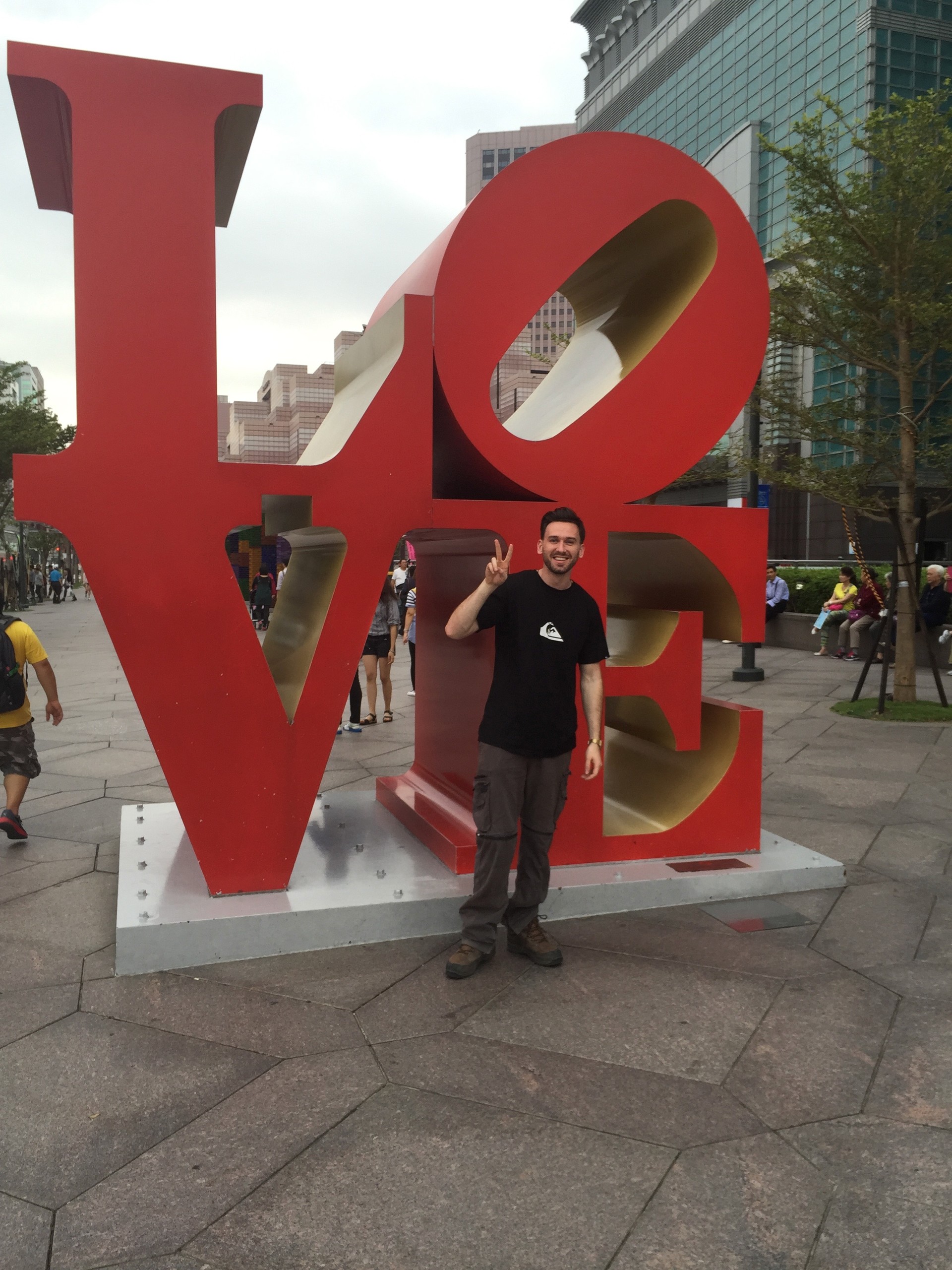
The former tallest building in the world boasts a shopping mall and an observatory. You have to pay to go in the observatory but the rest of the building is completely free to enter. You’ll need to take the Blue Line MRT and leave out of Exit 2, where there is a free shuttle bus. If you prefer to walk then leave out of Exit 3 and the building will be in clear sight and you can also just follow the flocks of people!
Later that night we went for tea in a coffee shop near Longshan temple. On the same street, we spotted a shop sign with a swastika on. Steffan took a picture in amazement. “You’d never see that in Germany! ” he exclaimed. I later discovered, any shop sign with a ‘swastika’ on means that the place sells vegetarian (mainly vegan) food, as it's a sign associated with the main religions in the country: Buddhism and Taoism. You can also usually eat out in these restaurants and many others for about $100NTD (£2. 50) I sat down in the coffee shop exhaustedly opposite my German acquaintance, drinking our tea in near silence. I’d spent nearly 12 hours with this guy and now we had nothing left to talk about. If I was silent too long I feared he would be able to smell the anxiety on me. “What am I doing here? ” I thought. “I can’t seriously expect to be able to teach kids, I should be back in the UK, I’m not cut out to be a teacher”. My mind began to dissociate. Stefan stared at me blankly as the anxiety began to dominate my thoughts and possibly my aura. The silence was unbearable. He made efforts to ask me about my new job, asking me if I’d taught before. I gave half-hearted replies, every word I said just placed more fears in my already doubt-ridden mind about my present situation.
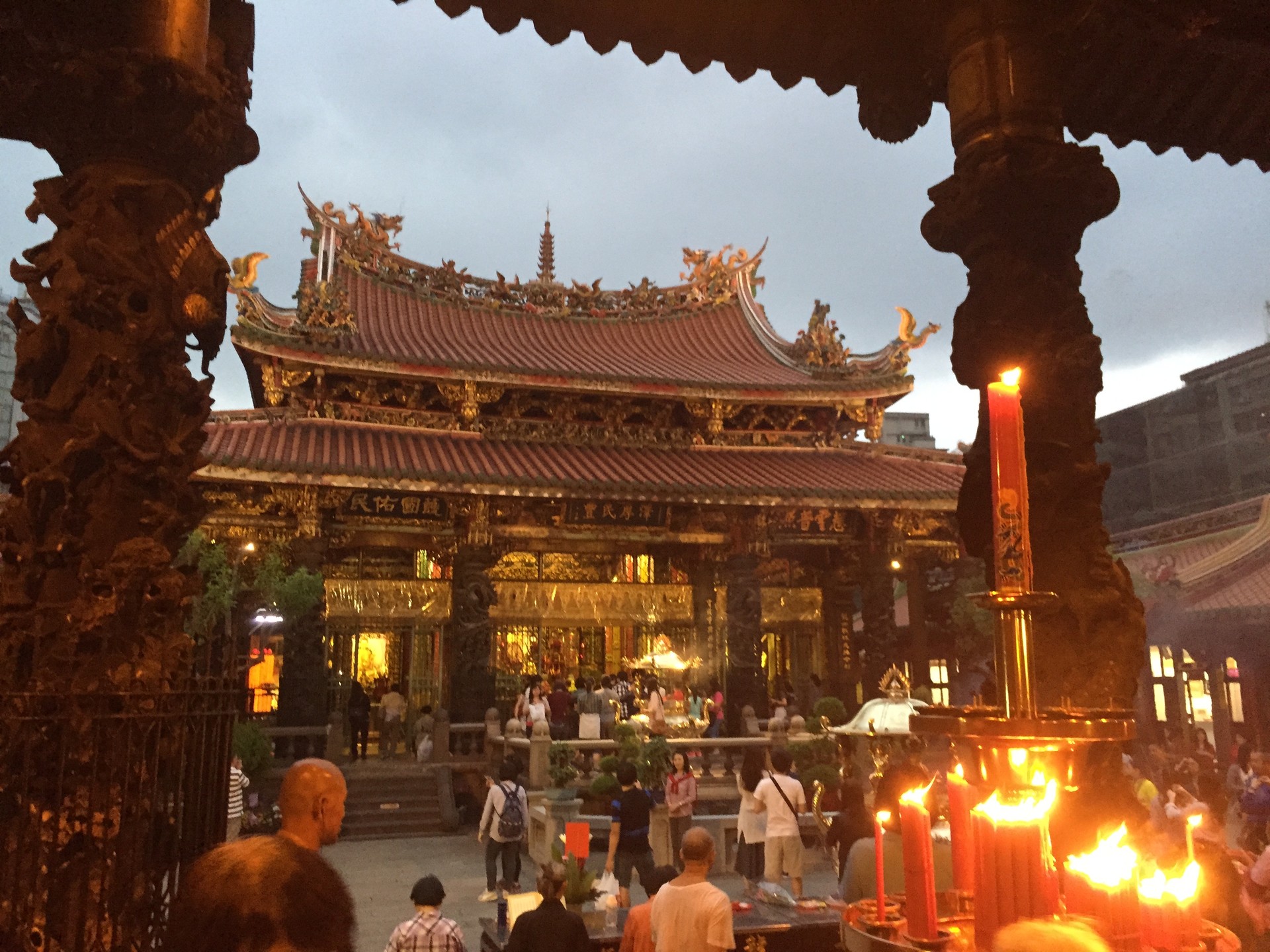
Longhshan also fortunately has its own stop on the MRT on the Blue Line. You’ll see hoards of locals burning incense as offerings so remember to be respectful at all times as this is still a religious site as well as a tourist attraction.
I travelled with Steffan back to Taipei Bus station. He had to get back to the airport to catch his connecting flight to New Zealand. I didn’t want him to go, his departure sentencing me once and for all to the profuse feeling of solitude that was already beginning to manifest within me. I walked back to my hotel passing a homeless guy lying on the top floor of the footbridge that crossed over the MRT station. This was the first ounce of poverty I’d seen in a city which seemed so economically prosperous. I got back to my room and took a hot bath. I grabbed my copy of “The Miracle of Mindfulness” by the Vietnamese Buddhist monk Thich Nhat Hanh. The words and the water momentarily soothed my consciousness. I sat in the bath until the water was tepid. The afternoon doubts had temporarily subsided. With Steffan gone, my fate was sealed: Here I was, alone, in a distant foreign country, destined to become an English as a Foreign Language Teacher.
As I tried to settle in to my new country of temporary residence (I’d committed to a year long contract) I couldn’t help but feel a sense of awe at this huge city marred by an overwhelming sense of dread at the precarious position I now found myself in. Here I was, in a foreign country, alone, surrounded by millions of people in a chaotic urban surrounding. My social anxiety was creeping up. I set my doubts aside and made efforts to settle in to my new surroundings as best I could. I went for strolls around the city’s parks and visited the museums, I took pictures and uploaded the half decent ones to Instagram, hoping to give the appearance of someone who’s stepped into a foreign culture and thriving. The reality couldn’t be further from the truth. I felt scared, alone, anxious – anything but someone who was flourishing in his new surroundings.
The hotel (if you can call it that), which I was staying in, was in an area called Gutin. It was a low budget place, the room felt kind of dirty and I’d heard rumours from the other teachers that it was a “Love hotel”, which is essentially a hotel used for one hour bookings to bring prostitutes to; a particular service I assure you I failed to render. There wasn’t much around the local area: a shady, small-scale nightmarket, a McDonalds, a Starbucks, a park and plenty of skyscrapers, but as with in any central area of Taipei you will have access to the MRT. One thing I would possibly suggest using in Taipei is Couchsurfing. Taiwanese people are incredibaly hospitable and although I only used the website in Kaohsiung, I'd be certain that it'd be easy to find a host in the capital and have an authentic experience of Taipei with locals.
Getting to sleep in Taipei proved to be an impossible task. I was quite staggered by just how many variations of sleeping tablets they sold here until I later discovered that Taiwan has the highest consumption of sleeping pills in the world! Its hardly a surprise, what with all the 24 hour 7-11 shops dotted on literally every single street corner, or especially if you’ve ever experienced the noise that emanates from the city centre of Taipei at 3AM each and every night. Whichever city it is that has the title ‘the city that never sleeps’ (is it New York? ) then step aside random city, Taipei is the new reigning world champion.
It was my second night in Taiwan. An hour passed, 2 hours passed, I couldn’t sleep. I got up and flicked the light switch on in the bathroom to see a cockroach scurry across the floor. I’d made a personal vow before coming to Taiwan that I wasn’t going to kill any insects due to my new interest in Buddhism, therefore I’d prepared for such a situation whilst back home. I’d read online that cockroaches hated catnip, so rummaging through my backpack I grabbed the jar I’d bought from the UK and scattered it across the floor. It made no difference, the cockroach was here to stay. That week things got worse. For the second consecutive, night I couldn’t sleep. This time there were two cockroaches and now one of them was in my bedroom. I’d heard how cockroaches are incredibly resilient, so my instincts told me to catch the little bugger and flush it down the toilet. I grabbed a piece of paper and a glass and chased it round the room. “Gotcha! ” I caught it and flushed him down the loo while the other was still at large somewhere in my room. Sleep was impossible now, I reached into the small compartment of my backpack and pulled out a pack of sleeping pills, not knowing if the dose was too high or too low, as the woman in the store’s English was about as good as my Chinese. I lay in bed waiting for the sedation to arise. I woke up unsure if I’d slept or not. I felt groggy and was late for my second day of teacher training, again.
What about the Pollution?
One thing I noticed rather quickly in Taipei was the abundance of people wearing facemasks. Initially I assumed this was for similar reasons to why people in Beijing famously wear them - to protect themselves from pollution. But was Taipei really thatpolluted? I’d barely noticed the air pollution thus far, despite the ravaging sound of scooters everywhere across the city, it seemed in fact as if the scooters were the only, or perhaps the main source of pollution in the city. I later discovered that usually the reason for people wearing face masks in Taiwan usually isn’t due to pollution, but rather, usually because the person wearing the mask is ill and doesn’t want to contaminate others. The pollution map of Taipei below, with data collected between 2000-2008, only shows one area consecutively falling into the ‘red zone’ or hazardous level:

On my third night in Taipei I found myself in a Takeaway Sushi store about to purchase and consume my first ever taste of Sushi with a fellow teacher-to-be named Seth from Michigan. At the time, as a recently turned pescetarian now living in Asia, (I’ve since gone vegan) I figured it’s best I get used to this stuff. As I delicately spread the wasabi onto my first piece inside the local MRT station, an elderly Taiwanese man walks up and politely says to us in perfect English “You can’t eat in here”. Startled, and feeling somewhat embarrassed, we picked up our sushi trays and made for the exits. The MRT stations themselves are impeccably clean and precise, litter is scarcely seen anywhere so you can’t really fault the system they currently have in place.
Taking the escalator as we headed out, I’m amazed to see an orderly line of people occupying the left side of the steps, whilst leaving the right side free for people to overtake. Thinking back to how escalators at train stations worked in the UK, this notion seems largely unthinkable to me and I’m left astounded by the overall efficiency of the MRT system here. People form orderly cues as they wait to board the train and actually let people off the train before trying to get on first, it seems an improvement on people pushing and shoving their way on or edging closer to the step whilst people exit. Consideration for others certainly seems more prevalent here in Taiwan than in the UK and that’s no more apparent than at the MRT station.
More things to do in Taipei:
I truly believe you could spend a year in Taipei and still always find something new and exciting to do. For spectacular views of the city, I advise going on the Maokong Gondola just before sunset. This is a fairly quiet time and it seems strange to be in a quiet district of a city which seems so chaotic. The station for the Gondola is located near the Wetland Park at the south of Taipei Zoo. The easiest way to get there is to take the Wenshan-Neihu Line of Taipei Metro to the Taipei Zoo Station and then walk to the Maokong Gondola, which is at the same station as the zoo.

For music and concerts, there’s a really cool concert hall called Legacy. In the picture above I was at an Olafur Arnalds concert with my friends Howard and Emily. The area around Legacy was quite a distinct creative, almost ‘bohemian’ vibe in comparison to the other areas of Taipei. That isn’t to say its not gentrified, it is, and incredibly so, but the surrounding restaurants and bars, interspersed with acoustic guitar performers and soothing atmosphere at times make you forget that you’re still at the heart of the chaos of the city. One really cool thing I liked about Taipei was the innovativeness of its use of space. Underneath road bridges and junctions you’ll often find pop-up basketball courts, filled at all hours by people having highly competitive games of basketball; it's a wonder how basketball isn’t their national sport (its actually baseball).
Nearest MRT station to Legacy: Zhōngxiào Xīnshēng Station.
Another place definitely worth checking out is Taipei Fine Arts Museum. Entry is free and the museum is one of the most renowned galleries in Asia, with one of the largest collections of modern art to boot. It has an incredibly contemporary feel on both the outside and inside.
Click here for some info on getting to the museum.
Taipei also has some really cool night markets too. Its most famous and supposedly oldest night market is Shilin, which is opposite the red line Jiantan MRT stop. Another popular and traditional market is Raohe Night market, which is literally just across the street from Songshan MRT stop.
If you’re a history buff or similarly want to educate yourself on Chinese culture, check out the National Palace Museum. Initially it seems quite isolated in comparison to other tourist spots in Taipei as its in the older district of Shilin, but its easily accessible by bus or MRT (to the stop at Shilin on the red line), and is open from 8:30am – 18:30pm every day and open until 21:00 on Fridays and Saturdays. Admission is $250NTD (roughly £5. 60).
Click here for info on getting to National Palace Museum.
Another place that’s easily accessible by MRT is CKS Memorial Hall, which is incredibly simple to get to as it has its own MRT station. The long title of the hall: ‘Chiang Kai-Shek’, was named after the former President and was built as recently as 1980. Its accessible by both the Red Line and the Green line. In the summer, the national Taiwanese flag is raised at 06:00am and lowered at 18:10. In the winter, the times are 8:30 and 17:10 respectively.
You’ll see a lot of Taiwanese flags in Taiwan and virtually no Chinese flags. This might come as a surprise, as on practically every document the abbreviation R. O. C (Republic of China) follows Taiwan. It's a long and complex story but Taiwan doesn’t yet have full autonomy granted by China. In fact, during my stay there the people democratically elected Tsai Ing-Wen to be President, who is said to be in favour of Taiwan becoming an independent state. This issue is a complex one and that is reflected in the views of the people there, with the majority of people I met in favour of Taiwan becoming independent. That isn’t to say however that there aren’t some people who pledge allegiance to the CCP, but there is an evident dichotomy in those who see themselves as a country already, and those who believe they are still just an off land area of China.
Finding a job and accommodation
Your best chance of securing work in Taiwan is by looking to the big cities first. It’s true that there are plenty of jobs in all regions of the country (particularly on the West Coast), but to maximise your chances, here I’ll discuss 4 of the major cities (all located on the West coast) in brief.
- Taipei – The northern capital and business mecca of Taiwan. More multicultural than other areas of the country but still with a distinctive Taiwanese feel to it.
- Kaohsiung – The south of the country and easily the ‘second city’. About an hour away from the glorious beaches of Kenting and Buddhist Temples such as Fo Guang Shan are also in this city.
- Taichung – In the middle of the two aforementioned cities. A growing expat community and well known for having much better weather than Taipei despite being only about 100km away!
- Tainan – The former capital of the country and cultural heritage hotspot. Famous for its nightmarkets and ancient buildings such as The Confucian Temple and Anping Fort, which was used by Dutch colonialists. Only about a 30-45 minute drive from Kaohsiung.
Most of the jobs are located on the west side of the island, which is where all the major cities such as Taipei, Taichung, Tainan and Kaohsiung are located. There are plenty of opportunities for native English speakers and degree holders to find teaching jobs in any of these places. I’d taken a position for a franchise called ‘Shane English’ at what in Taiwan is known as a ‘busheeban’ or ‘cram school’ in Taichung. Cram schools are essentially after-hours classes where the unique selling point is the kids are supposed to ‘have fun’ whilst learning. But before the job began, I had to get the obligatory week of training underway at the head office in Taipei. I’d secured the job online before heading over to Taiwan through a website called Dave’s ESL Café, which lists ESL job postings from all across the world.
What you'll (usually) need to get a job:
- A degree
- Passport photo (for your ARC card and working visa)
- TEFL certificate.
Another slightly more risqué option to finding work in Taiwan if you don’t have a degree is to just go over there and see what you can find. Visitors are granted a 90-day tourist visa upon arrival and in this period there’s plenty of time to travel the country and find work. One great website for finding work is TeaLit (Teaching English and Living in Taiwan), which posts ESL jobs all around Taiwan. There’s also a Facebook group called ‘Taiwan ESL Teachers’ where practically dozens of jobs are posted every day. I’ve heard of some stories of people going over to Taiwan on a tourist visa, working for 3 months and then leaving the country every 90 days in order to renew their visa and be eligible to work once more, though I’m not quite sure of the legality of this and am by no means advocating it!
One usual prerequisite for finding a job is having a degree, and completing a 120-Hour online TEFL course, as these are usually what are required in order for a potential employer to sponsor you for your visa requirements. I scoured reviews to find out which TEFL course I should do using a website called ‘TEFL Course Review’ and settled on a company called Love TEFL and managed to find a reasonably priced course for £100. Occasionally there are offers for cheaper courses on the website GroupOn, but overall for the price I paid, I was happy with LoveTEFL considering the amount of job opportunities it managed to open up for me. One more expensive but certainly more ‘professional’ option would be taking the Cambridge listed CELTA course, which costs roughly £1000 and lasts around a month. It is all face-to-face learning and focuses primarily on teaching adults, with the course itself an intensive introduction/furthering in to learning how to teach English as a foreign language. If you don’t have a degree or a TEFL your options are limited and the best advice I could give would be just to go over there and see what you can find. Having a TEFL certificate is definitely a plus but not always a necessity and just by being in the country you increase your chances of finding a job dramatically.
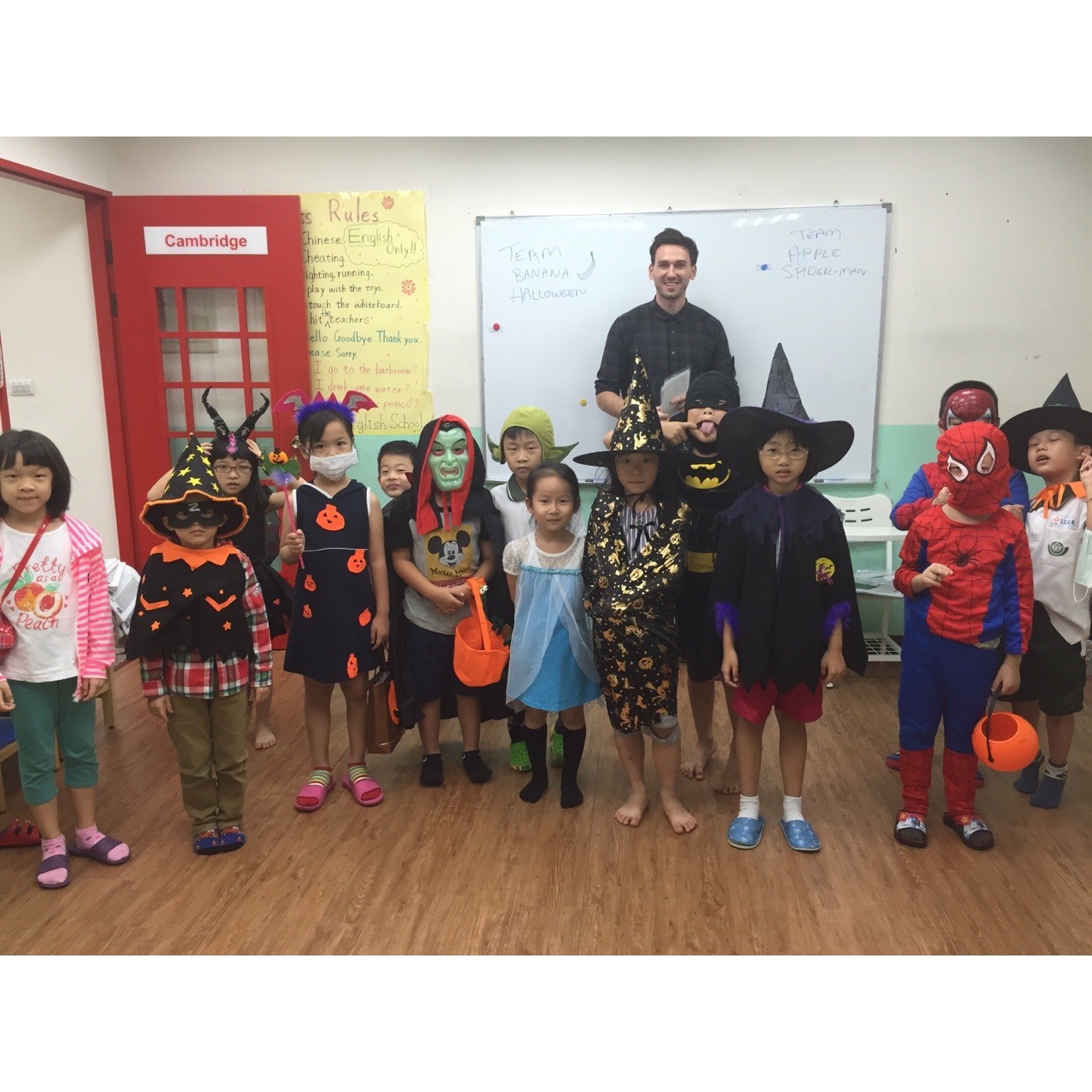
My school was based in Taichung (about a 2 hour drive from Taipei) and they managed to get me an ARC (alien residency card), which gave me the right as a foreigner - or an ‘alien’ as they liked to put it - to work there.
I found my own accommodation using a website called 591. The site is all in Chinese so if you don’t know anyone who can read Chinese (like I didn’t), then you can browse through chrome and chrome will give you the option to translate the page into English. I was paying $7, 500 NTD a month for my apartment, less than £200. I was staying in the Xitun (South) District of Taichung and had my own room, en-suite bathroom and a shared kitchen with three other native Taiwanese people who were, like most Taiwanese people, incredibly friendly. The price I paid just goes to show some of the deals you can get outside of Taipei. If this had been in Taipei, I’d have probably payed closer to $11, 000 - $14, 000 in the city centre, possibly less in ‘New Taipei City’, which is a cheaper district of Taipei when it comes to accommodation.
As well as my ARC, my school set me up with a health insurance card. Health insurance gives you the right to use medical treatment in any doctor’s surgery or hospital, and anything you wish to see a doctor for will cost you a meagre $150 NTD (roughly £3. 80). On one occasion, I needed to see a dentist urgently. It was 9pm in the evening and I was in my local neighbourhood and spotted a local dentist. I simply walked in, had the area of my mouth seen to there and then, was given some antibiotics and by the next day everything was fine! Doctors’ surgeries and dentists often stay open until around 9:30pm in Taiwan, which is handy when you’re in dire need as I was! If you’re in need of ‘western medicine’ however, look out for the two different types of surgeries, as there is a lot of Chinese medicine still sold in Taiwan through official Eastern medicine official practices. These surgeries often look identical to other surgeries, so unless you’re after some cheap acupuncture, which I personally used from time-to-time, make sure to find out if it's a ‘Western medicine’ clinic or an ‘Eastern medicine’ one. Occasionally it will be evident through symbols used such as ying and yang on the window or if acupuncture is practiced there. Here’s me getting some acupuncture for 150NTD (£3. 60):
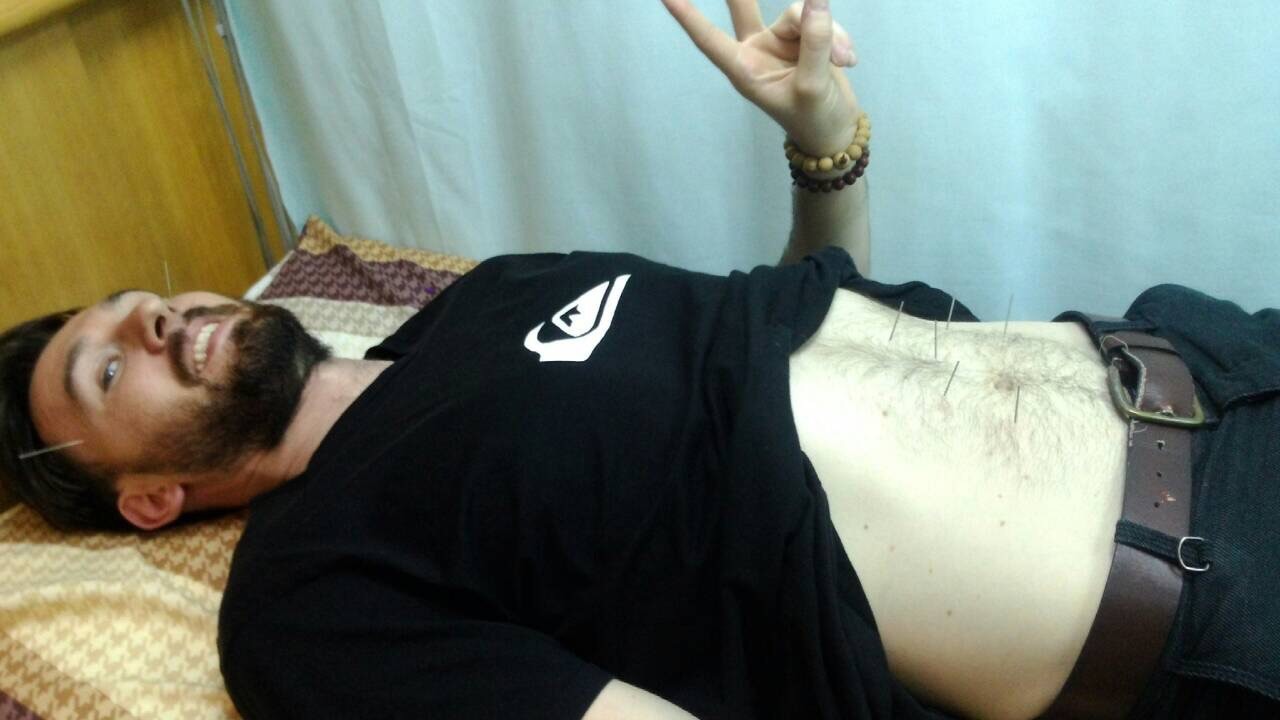
Taichung
Finally the day came to make my trip to Taichung. A fellow teacher to be had arranged for his Taiwanese friends to give us a ride to Taichung, which was about 2 hours away by car. The first night there the school had arranged for me to stay in a nearby hotel. It seemed instantaneously evident that not only did Taichung have better weather than Taipei, but Taichung was more polluted than Taipei. That's mainly because the largest coal burning power plant in the world is in Taichung, which similarly makes it one of the most polluting plants in the world. That said, the pollution in Taichung is by no means comparable to any of the major mainland Chinese cities like Shanghai or Beijing, possibly not even a quarter as bad. Finally when we arrived I peered out of my window to the glorious sight of skyscrapers and sunny but smoggy, skies. For the next 12 months, I was home.
Settling into Taichung seemed much easier than I thought. A really helpful group for anyone planning to live in Taichung called Taichung Info exchange, where expats and locals regularly do as the title suggests and exchange useful information regarding the city such as events, places to go and things to do. Fortunately I arrived in October, when temperatures aren't too high and the annual Jazz Festival is held at Civic Square Park, which made for a nice introduction to the city! Thanks to the fairly large expat community in Taichung, they’re also incredibly helpful when it comes to asking for general advice for foreigners (which I often needed to do! )
Getting around
The bus is another simple way of getting around, especially outside of Taipei. In cities like Taichung where there is no MRT, when using your Easy Card card, the first 8km of your bus ride is free! Another easy way to get around any major city in Taiwan (Taipei, Taichung, Tainan, Kaohsiung) is by renting a YouBike, which you’ll spot locals riding on a mile away due to their fluorescent orange and yellow colour. To do so, you can use an ‘Easy Card’, which are the same cards you can use for the bus or MRT. You can buy these in store but you’ll have to make sure there’s a machine next to the YouBike station, which you can scan your card with.
By far the most popular option is traveling by scooter, which many of the locals choose to do, whichever city you’re You can buy a scooter secondhand for as little as $12, 000NTD (£300) though I’ve heard of people getting them for around 9, 000NTD too. The best place to find one would be in the Facebook groups “Taichung buy, swap, sell’ or the group of the same name for Taipei, depending on which city you’re in.
Renting a scooter unfortunately isn’t straightforward in Taiwan. The only places I managed to find which rented them were random guys situated next to Taichung Train Station and Kaohsiung Train Station. To rent or buy a bike, you need to arrange an international driver’s license before you head overseas. This can be a lengthy process so its best to do it at least a few weeks before you travel. Here is a link for how to set it up in the UK:
UK International Driver's License
What about the Language Barrier?
Okay, so outside of Taipei you might have some issues with the language barrier. But Taipei is very catering towards tourists and thus you’ll find many signs in English as well as lots of English speakers.
I was personally living in Taichung and the teaching (and language learning) was getting easier and all of my doubts had finally gone. I struggled (just a bit! ) with the language, but I was told about language classes being taught at TLI, which charged $5, 000NTD a month for 10 hours a week classes. In terms of socialising, I’d managed to meet and make friends through an online Facebook group called “Taiwan Friendship Exchange” and found an online language exchange partner, who would later become my best friend in the country through another Facebook group called ‘Taichung Language Exchange’. If you’re in Taipei however you can also check out the language courses on offer at the Normal Taipei University.
So fortunately the language barrier fortunately wasn’t too difficult for me. I honestly believe Taiwan must be one of the easiest countries in the world to make friends as not only are people incredibly friendly, they are also incredibly helpful, and once you have a Taiwanese friend in your life, you know they’ll do anything for you (within reason! ) I remember an occasion where I walked past a store, was invited in and ended up talking for about an hour with the guy who worked there and his colleagues. He told me I was the first ‘laowai’ or ‘foreigner’ to ever to come in his shop and made such a big fuss over me. After talking for a while, and the taking a dozen selfies – which you will find is an obligatory custom in Taiwan - I left the shop, added him on LINE (the most popular messaging app in Taiwan), and made plans to go out with them all that weekend!
With that being said about the language, perhaps I can shed some guidance here and offer some basic tips. Their first language is Mandarin Chinese and second is Taiwanese but the level of English is good I’d say (at least in Taipei it is). It is still good custom however to at least learn a few phrases but the first thing you need to learn in Chinese is the tones!
Survival Chinese
There are four tones of Chinese, so the first thing to do is to try and memorise them through YouTube. The sentences below all have the tones indicated by the character, which reflects how your tone should be. Here are some examples using the word ma:
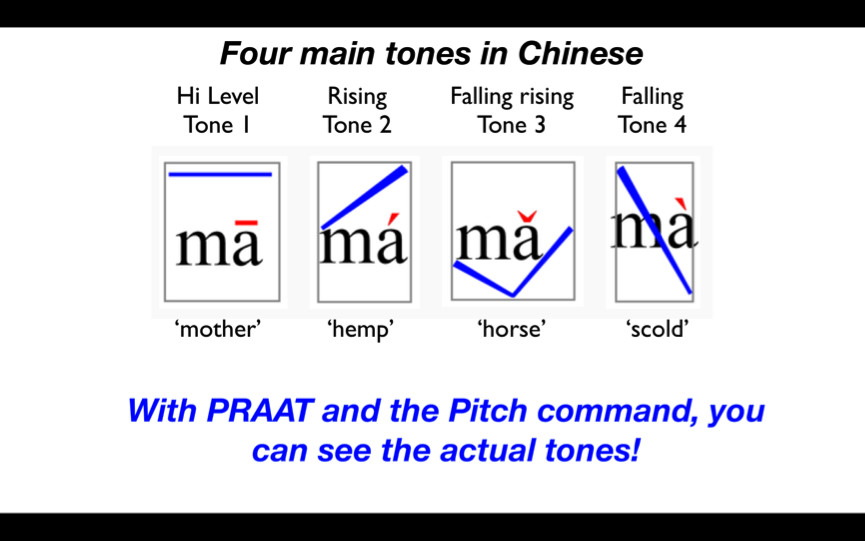
- Number 1 (mother) is the ‘highest tone’, and consistently stays at the same tone.
- Number 2 (hemp) is a rising tone, so you raise the tone as you say it.
- Number 3 (horse) is the falling-rising tone goes down in tone then up in tone.
- Number 4 (scold) is the falling in tone from beginning to end.
Here's a video to explain the tones more thoroughly.
- Nĭ hăo - Hello – literal translation: ‘You Good” (pronounced knee how)
- Nĭ hăo ma? – How are you? (pronounced: knee how ma? )
- Hen hăo – Very Good (pronounced: hen how)
- Xièxie – Thank You (pronounced similar to: shi shi)
- Bùhǎoyìsī – Sorry – pronounced: boo-how-ee-sa
- Nǐ-jiào-shén-me-míng-zì? – What is your name? (pronounced:vknee-jow-shema-meenza)
- Wǒ de zhōngwén bù hǎo - My Chinese is not good - (pronounced: wu de zongwen boo how)
- Wǒ yào – I want – (pronounced: wu yow)
- Fàn – Rice
- Bù yào ròu – I don’t want meat (for any vegans/vegetarians - rou pronounced row)
If that’s all too much to take in, here’s a funny (and fairly accurate) way of remembering and saying certain phrases through using English pronunciation:

Arts and Culture
Taiwan is renowned for its tea, mountains, landscape, culture and night markets. Fortunately I was living in Taichung, which has one of the most famous night markets in the country, situated next to Feng Chia University in Xitun (South) District. It was here I had my first taste of ‘stinky tofu’, the infamous national delicacy that you can quite literally smell from blocks away. Think back to the smelliest cheese you’ve ever encountered and multiply it by 100, then you’re getting fairly close to just how stinky this tofu is. Whilst in Taiwan another famous national ‘delicacy’ you’ll have to try - as it’s quite literally sold everywhere – is bubble tea. Its essentially black tea, with either milk or soy milk and bubbles (tapioca) inside which you drink through a plastic cup and suck up the tapioca through a straw.
Another place of interest is The Confucian Temple. Until recently, the city lacked a Confucian Temple, which many other cities boast. The council addressed this and thus the temple was constructed in 1974. It is one of the youngest Confucian temples in Taiwan. It is also free to visit. One of my favourite pastimes however was Wu Wei Tsao Teahouse on Gongyi road in Natun (North) District. Here you can enjoy a cup of chai in a traditional Japanese tea house setting, complete with its own Japanese style garden!
If you’re interested in the arts, fortunately Taichung has the National Museum of Fine Arts, which is free to visit. It’s located in Nantun District and is fairly centrally located. There’s also the National Museum of Natural Science, which depending on which rooms you want access to, usually costs around $120NTD per ticket.
With Taipei being only a couple of hours away by bus, I visited there frequently for a modest price of around 250NTD and would usually stay over in a friends house, whom I’d met through the Facebook group previously mentioned. The other option is to get there by High Speed Rail, which gets you there in around 30 minutes for 1000NTD. Taichung is in between the two major cities of Taipei and Tainan, and both are easy and cheap places to visit. I would get the bus from Xitun (South) District at the bus station located next to Tiger City Multiplex and would usually travel with a company called ‘Hso-Hsin’ (the red bus). Tiger City itself is a cinema complex and shopping mall, with restaurants, coffee shops and boutiques. Cinemas in Taiwan get all the major ‘Hollywood releases’ and fortunately they don’t overdub the sound into Chinese. Whilst I was over there, I watched the latest James Bond film at the time and the new Star Wars!
Day Trips & Excursions:
Naturally, Taipei is the most accessible city in all of Taiwan so wherever you’re planning to visit, you can either get there by bus or if you’re in a hurry, by High Speed Rail. You can get to the main city on the other side of the island (Kaohsiung) in about an hour this way. One other more ‘natural’ place, which you can get to in about an hour is Yilan. Yilan is a surfer’s town on the east coast of the island, also famous for its hot springs. You can’t get to Yilan from Taichung without passing through Taipei (unless you drive through the winding roads of the mountains through the centre of the island of course! ) Fortunately, as I explained in the last paragraph, getting to Taipei from Taichung is very straightforward.
Here are some instructions how to get to Yilan from Taipei, the airport and from Kaohsiung

There's a reason Portuguese travelers historically named this country Formosa; meaning beauitful island. One place that you can visit which fits this description well is in Yilan: Wufengchi Waterfall (pictured above). Again this place isn’t easily accessible by public transport so renting or buying a car/scooter would perhaps be the best option, though I personally managed to get there by car with my Taiwanese friend Howard. As I stated earlier Yilan is on the East Coast of the island, which is widely regarded as the less cosmopolitan, more 'natural' side of Taiwan. People generally head to places such as Toruko Gorge in Hualien as well as Taitung, both known for their stunning areas of natural beauty. Here's a picture took with my friend and language exchange buddy Fleming in Taitung that perfectly encapsulates the beauty of Taitung (and similarly of Taiwan):
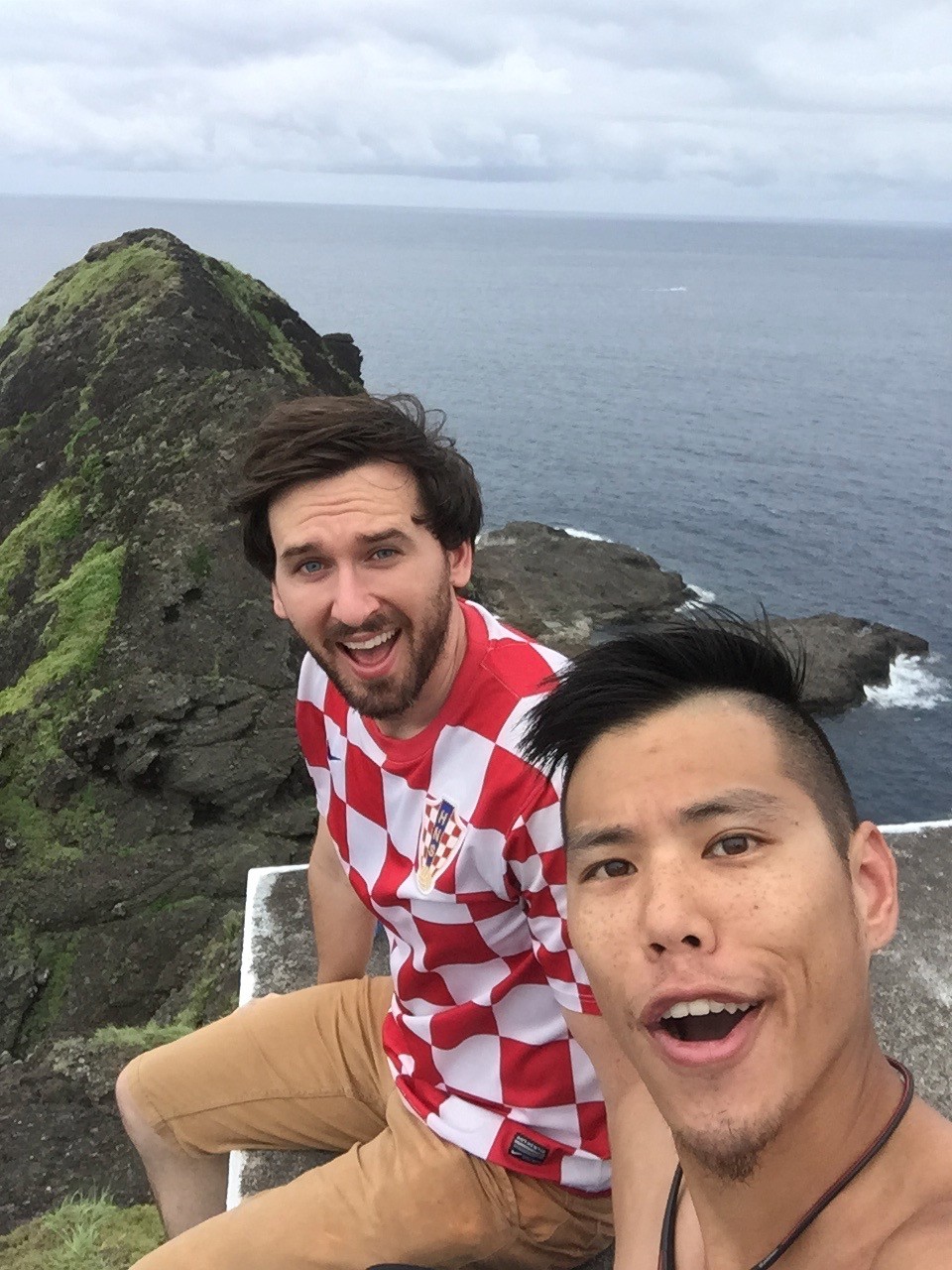
In Taichung however, another option is Rainbow Village or Caihongjuan Village as its known to the locals. Its a small yet fairly lively area of the city, where all of the buildings (there aren't many) are painted inside and out. The story goes that an elderly gentleman who lived in the area decided to paint his house and the conjoining areas in bright colours as an amusement piece for the local children. The site has since gone on to become a famous attraction in the city:
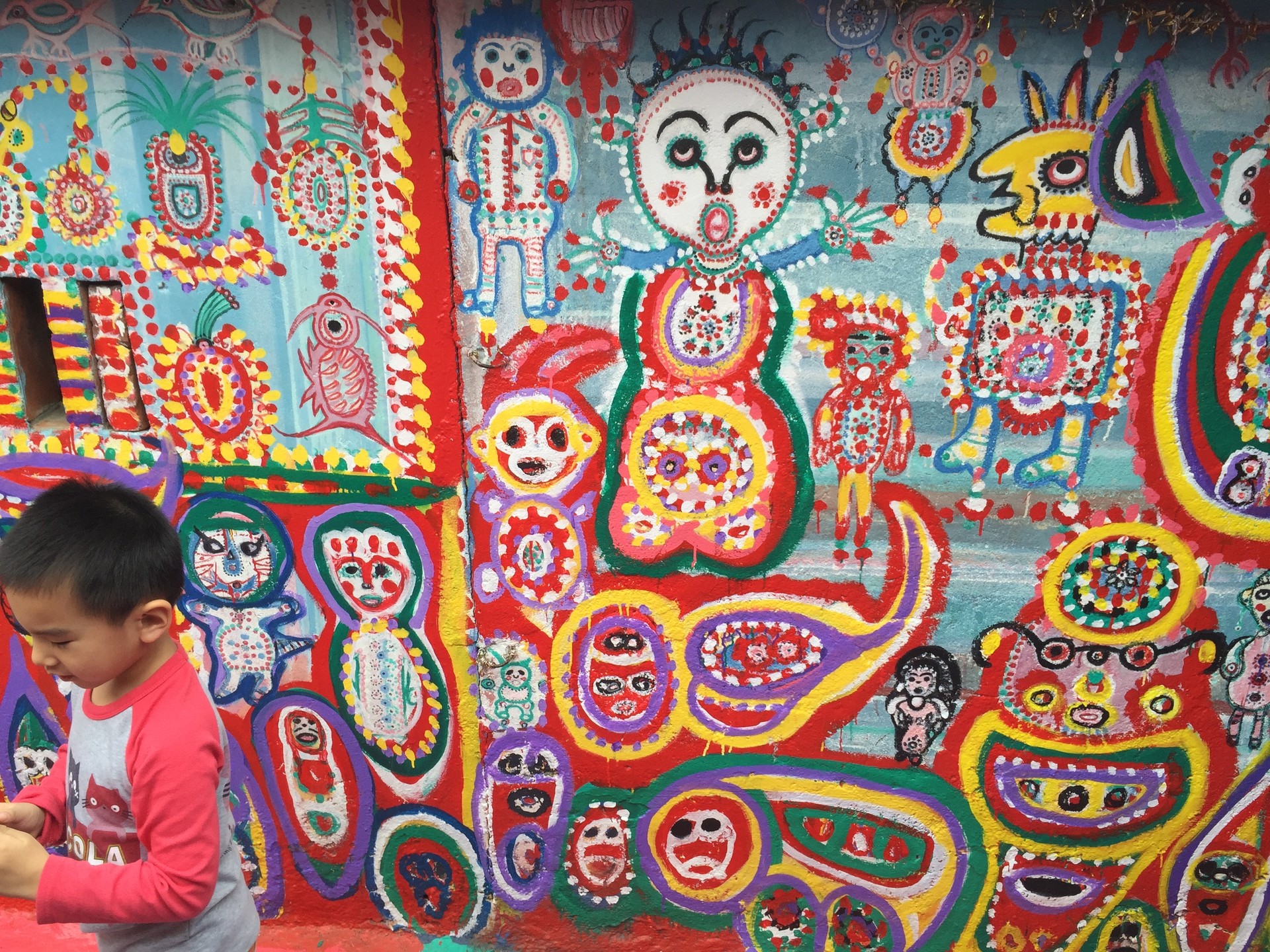
Whilst not necessarily an 'excursion', its worth mentioning hear that you can find some incredibly cheap flights to Hong Kong from Taichung (less than £40) and around the same price for flights to the Philippines from Taipei. Check skyscanner regularly for new deals.
A place that can’t be left out of this entry is Sun Moon Lake. Famous for its tea, and of course its stunning lake, it’s about a 1-hour drive from Taichung, so if your budget permitted you could get a taxi (cabs are pretty cheap in Taiwan. ) Your best bet of public transportation would be busses that leave from Taichung train station and it would be wise to either book in advance or get there early!
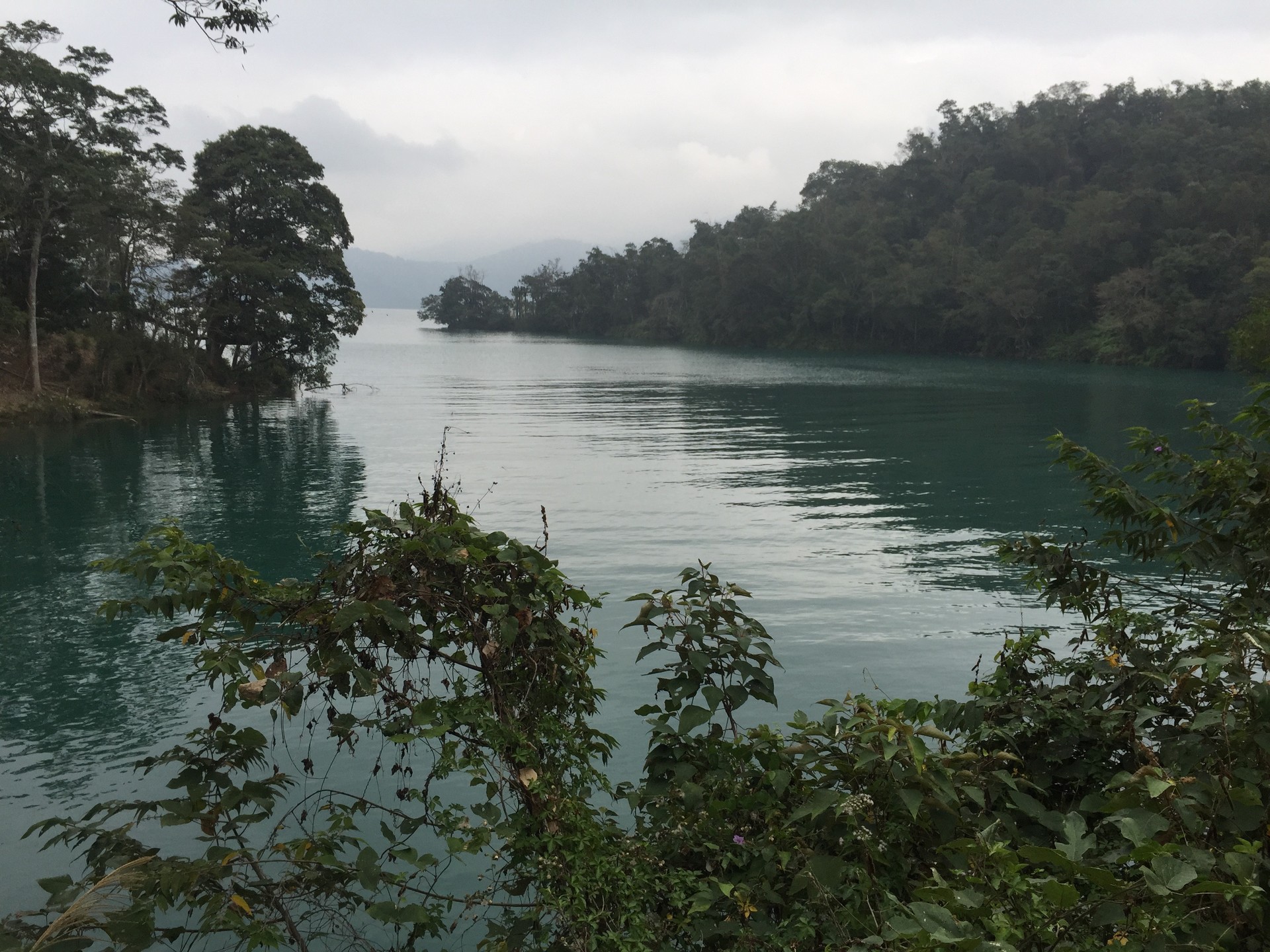
Here is some information on different stops you can get the bus from on their website.
Usually there are stunning views of the mountains to be seen from the lake, but my friend and I went on a rather foggy day but still managed to soak up the beauty of the pagodas and the village.
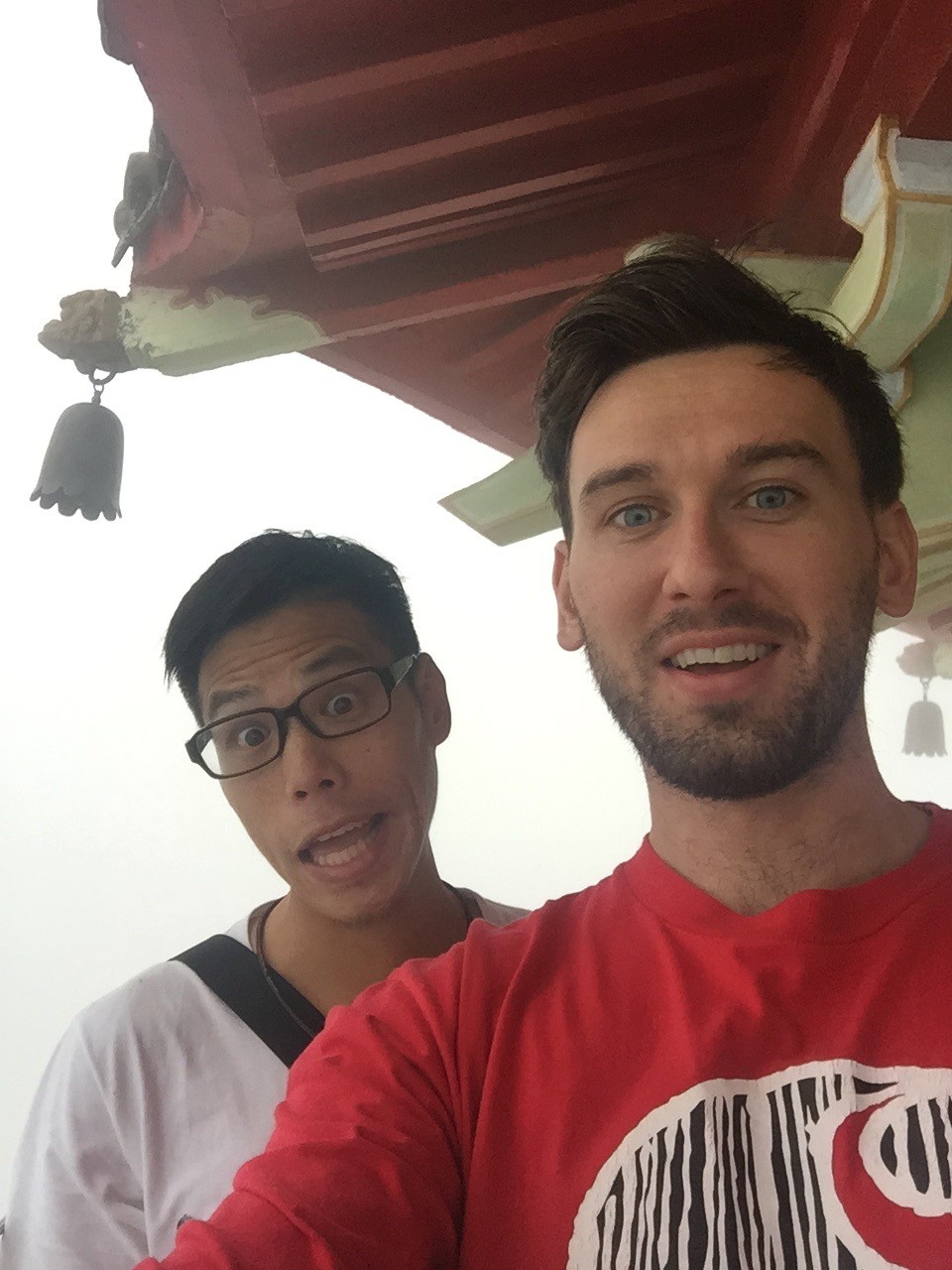
Another worthy mention and less touristic option is Yuan Zui Mountain, (translates to ‘The Eagle’) which has beautiful views but is also quite dangerous, as you really have to do a lot of scrambling up some vertical points. We’d been told tales by a one of the local guides about a German girl who had died there after falling earlier that year. Since that accident the council had made efforts to make the route safer by adding ropes to climb up and guide the way.
Yuan Zui (pictured below) is about an hour away from Taichung and pretty much the only way you can reach there from the city is by car or if you wish to travel like most locals, by scooter, as Taichung doesn’t (yet) have an MRT like Taipei.
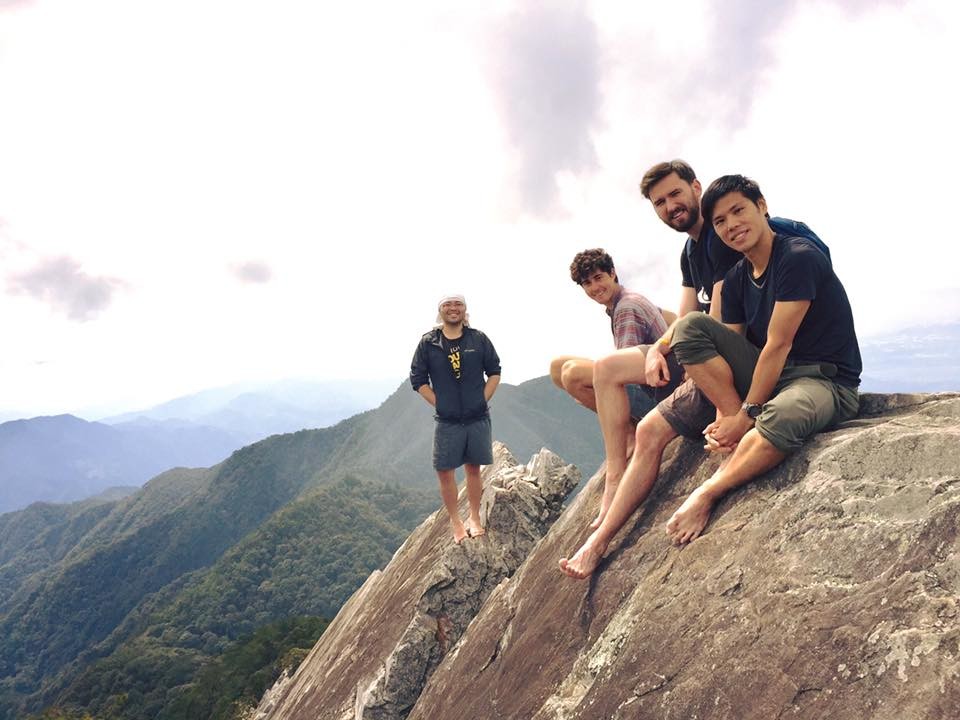
Other mountains in Taiwan include Snow Mountain, one of the biggest in the country and named so because in winter there is often snow at the summit. It is also fairly accessible from Taichung by road. There is a group on the website ‘Meetup’ as well as Facebook called Taiwan Adventures specifically made for guided hikes around Taiwan and you can pay to go on expeditions with experienced hikers who know the best routes. There’s also a Facebook group specifically for Yuang Zhu Mountain.
One of the most "accessible" days out in Taichung however is Gao Mei Wet Lands (pictured below). To get there take a train from Taichung Central Train Station to Qingshui, then take ‘Jeya Bus’ to Gaomeiand get off at the last stop. It’s just a five-minute walk from here and the journey in total takes about an hour.
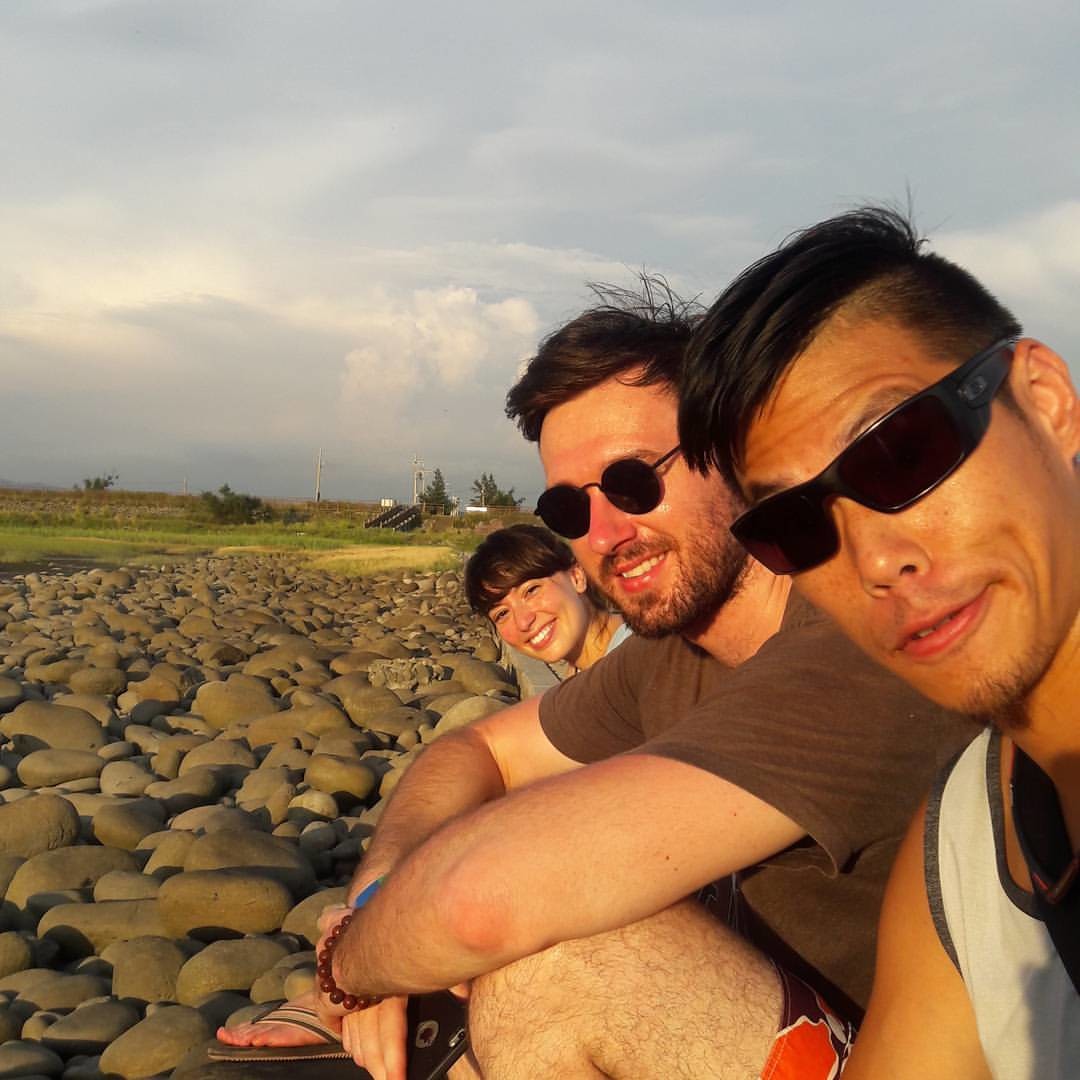
Buddhism and Temples
Buddhism and also Taoism are ubiquitous in Taiwan and you’ll find a temple in any town you visit. At times it might be difficult to understand which temple is for which religion, as they can often be (and are often) assimilated into one hugely decorated and impressive temple.
Chinese New Year is a huge celebration in Taiwan and everyone gets a week off work to commemorate it. I’d planned my week out by volunteering to work at a Buddhist temple in Puli I’d visited a couple of months earlier called Chung Tai Chan Monastery. I’d decided to make the plan of not bringing my phone, laptop, or any books with me, as I wanted to try out the ascetic Buddhist monastery lifestyle, albeit for only ten days. I’d found out there was a 7 day meditation retreat going on whilst I’d be working there. I’d narrowly managed to miss the application date for it, I was basically treating this work as my own mini 10-day retreat - whatever task they set me, I was to do it, mindfully.
It was the Friday commencing before Chinese New Year. I’d booked the day off work to ensure an extra long break - a chance to do some traveling for most - I’d played with the idea of traveling around the island myself before settling on the decision to volunteer at the Monastery. I left my apartment building unshaven, equipped with my huge rucksack to compete the amateur backpacker look. A scenic 50-minute bus ride from Taichung Train Station to Puli in the neigbouring county of Nantou got me there mid-afternoon. The trip cost less than 200NTD. For the entire journey mountains, rock barriers, streams and lush green scenery surrounded me on each side; visiting Puli is worth it for the bus ride alone. I walked around the centre of the small town. It seemed suprisingly urbanised and built-up compared to the mountainous surroundings I’d remembered encountering during my last visit to the monastery, where I didn’t get a chance to see the surrounding town.
I haggled a taxi down from $300 to $200 (NTD), proving to be one of my first, if not only successful attempts of bargaining since I’d been in Taiwan. Bargaining isn’t common practice in Taiwan and it can actually be seen quite rude if you try to haggle. Taiwanese people often won’t try to take advantage of you because your foreign in a bid to jack up the price as you might experience in other countries. However that isn’t to say that it can’t happen, but I’d expect it extremely unlikely and I never really suffered any problems with it.
I gallantly approached the enormous monastery gates, now resembling more of a palace than a spiritual place of residency - its tall white tower embellished by a gold pinpoint ornament at the top, surrounded by gold relics either side casting an intimidating yet noble appearance.
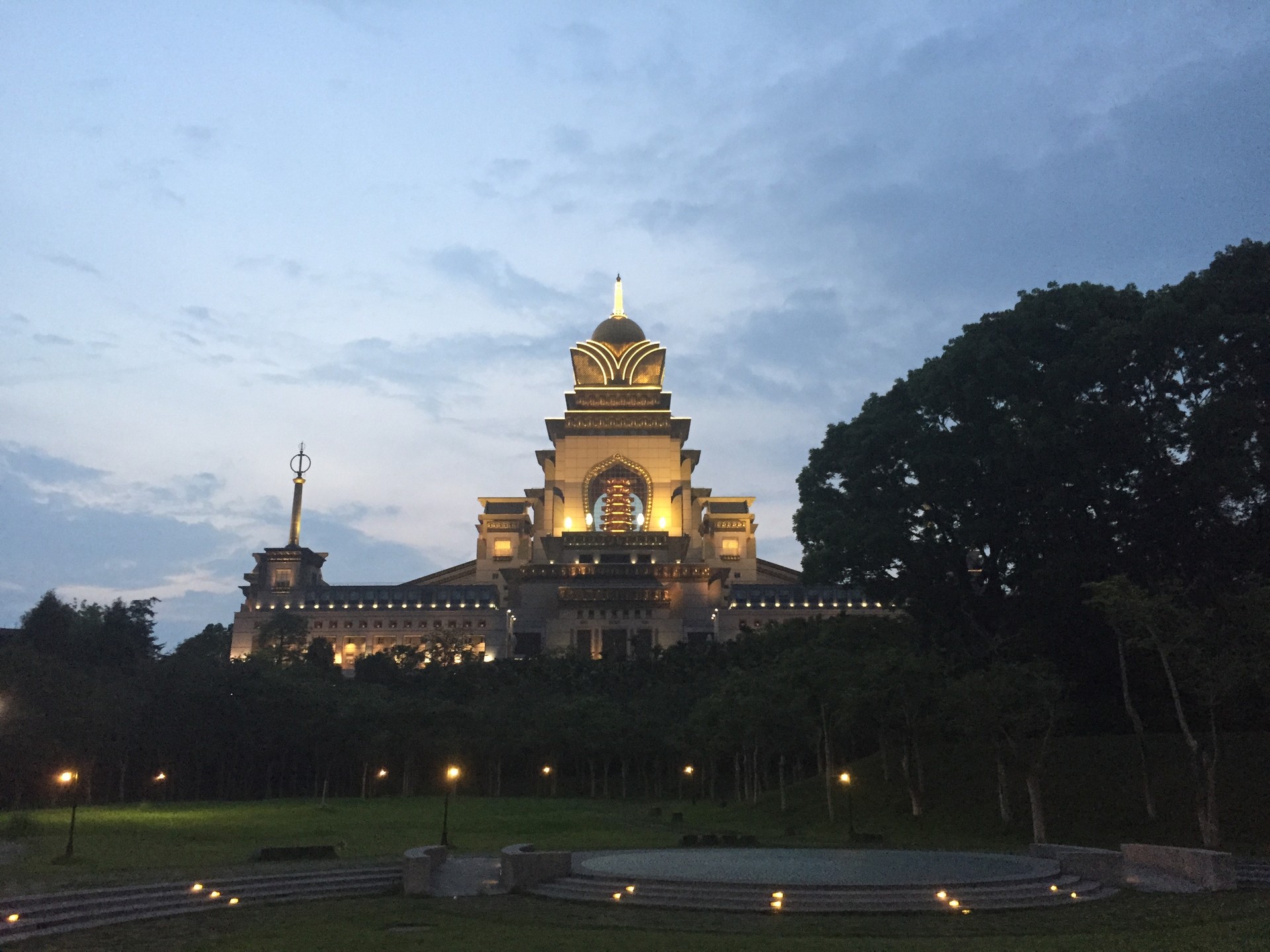
I was lucky to even get a place volunteering at the temple, as they usually only reserve volunteering spaces for people who speak Chinese. I managed to secure my volunteer position by visiting Pukai Meditation Centre in the Xitun (South) District of Taichung and registering as a ‘member’. I arrived at the reception of the monastery in the same manner as one would check in for a hotel. I was shown to the office where I arrived to the sight of a large assembly of monks and nuns huddled in their desks gazing at computer screens, talking on telephones and nomadically wandering around the office. It was like stumbling into any atypical call centre; a call centre with Buddhist monks and nuns as its call staff. In my mind’s eye I pictured them discussing stocks with one another, making frantic calls to secure the next ‘big deal’ over in Taipei or better yet in New York. Suddenly I dropped this thought and remembered where exactly I was.
It was plain to see how a place like this would require such technological modern maintenance, after all, they weren’t just attending to the needs and requirements of monks and nuns, they were serving the local community, as well as the hoards of tourists who visited the temple daily. One of the few nuns who spoke proficient English came up and remarked: “Wow the size of your backpack! ” I let out an embarrassed half-laugh. “Have you had your lunch yet? ” she asked. My thoughts trailed back to the wonderful vegetarian cuisine on offer during my last stay. Upon gorging down my deliciously compact meal of tofu, veg and some sort of seasoning, I settled into my new surroundings.
I was shown to my dorm by one of the helpers, closing the door, leaving me alone in my new habitat. As I looked out of the window, I felt a sudden sense of beauty and wonder at the exquisite garden and the sound and sight of tiny birds nestling from tree to tree. The smoggy, sky-scraper laden skies of Taichung seemed a million miles away from here, despite only being less than an hour away by car.
I reported to the voluntary work-base I’d been assigned to that evening. I was working for the transit department, but in hindsight the naming of such seemed rather arbitrary, as I could have just as easily been working in any other department based on the jobs they gave me. The work that evening consisted of laying out carpets in the main entrance for the imminent arrival of pilgrims for Chinese New Year. As me and the fellow volunteers lay carpets together, I stopped to take-in the breathtaking view from the entrance, watching the sun setting beneath the mountains that enclosed the premises, I was already feeling sure I’d made the right decision coming here.

That night I shared a dorm with another young Taiwanese volunteer. Upon making eye contact, we nodded in acknowledgement of one another. Not one to trial out my embarrassingly limited Chinese vocabulary, we refrained from dialogue that night, sharing a wooden floor for a bed in a modest yet ably comfortable room.
That evening (morning) I wake up at 04:00am and the room is shaking – that’s no exaggeration, the room, in its entirety was shaking. I woke up briefly: “Wow, that’s some strong wind! ” I thought, cursing the solidity of the building before gently dozing back to sleep. As I reported for work at 06:00am the following morning I discovered that it hadn’t been strong wind at all but rather an earthquake, and quite a serious one. Two buildings had fell down in the city of Tainan, the former capital of Taiwan and a major cultural heritage spot, about a 70km drive from where I was staying. Earthquakes are a fairly common occurrence in Taiwan, though I only remember encountering this one in my whole of my time there. The most serious happened in the 1990s, where local towns belonging to the same county as the monastery were devastated. I had attempted to resist the urge of using my iPhone for the entirety of my stay, in the futile hope of making the week my own mini 9-day meditation retreat. That evening however, I felt the urge to turn on my phone to an oncoming flurry of messages from family and friends, expressing concern for me upon hearing about the earthquake. I discovered people had died as a result, making my dubious prognosis of strong wind now severely undermined. That morning I was sent to work in the kitchen, helping pour buckets of rice into large pans, I clumsily dumped the entire bucket in a pan of sauce, splattering out of either side, and instantly staining a nearby monk’s garments! I apologetically muttered “duìbùqǐ” (Chinese for sorry) and edged away from the cooking area. Being a monk, I'm sure he easily forgave me!
Fo Guang Shan Monastery - Kaohsiung
If there was one experience I cherished most about Taiwan, it would have to be getting to have the opportunity to stay in Buddhist temples such as Chung Tai Chan and Fo Guang Shan in Kaohsiung, where, if you’re not interested in doing any meditation, you can still pay a small fee (about 150NTD per night) to stay in overnight and soak up monastic lifestyle; eating lunch in mindful silence with monks is a particularly notable experience. Fo Guang Shan occasionally offer weekend meditation retreats about once every 3 months so if you’re lucky enough to be in the country whilst one is happening and wish to do one, you can register or enquire on their website link below. Be warned, their practice is influenced by the Japanese tradition of Zen, so these weekends are pretty intense! Waking up to the sound of gongs at 5AM is a daily occurrence. Getting to Kaohsiung is straightforward from both Taichung and Taipei as you can get there by High Speed Rail, train or by bus. If you visit Fo Guang Shan, try to make an effort to meet the quirky Austrian monk Hue Shou, who often accompanies foreigners on their visits to the temple. Tell him Michael sent you; )
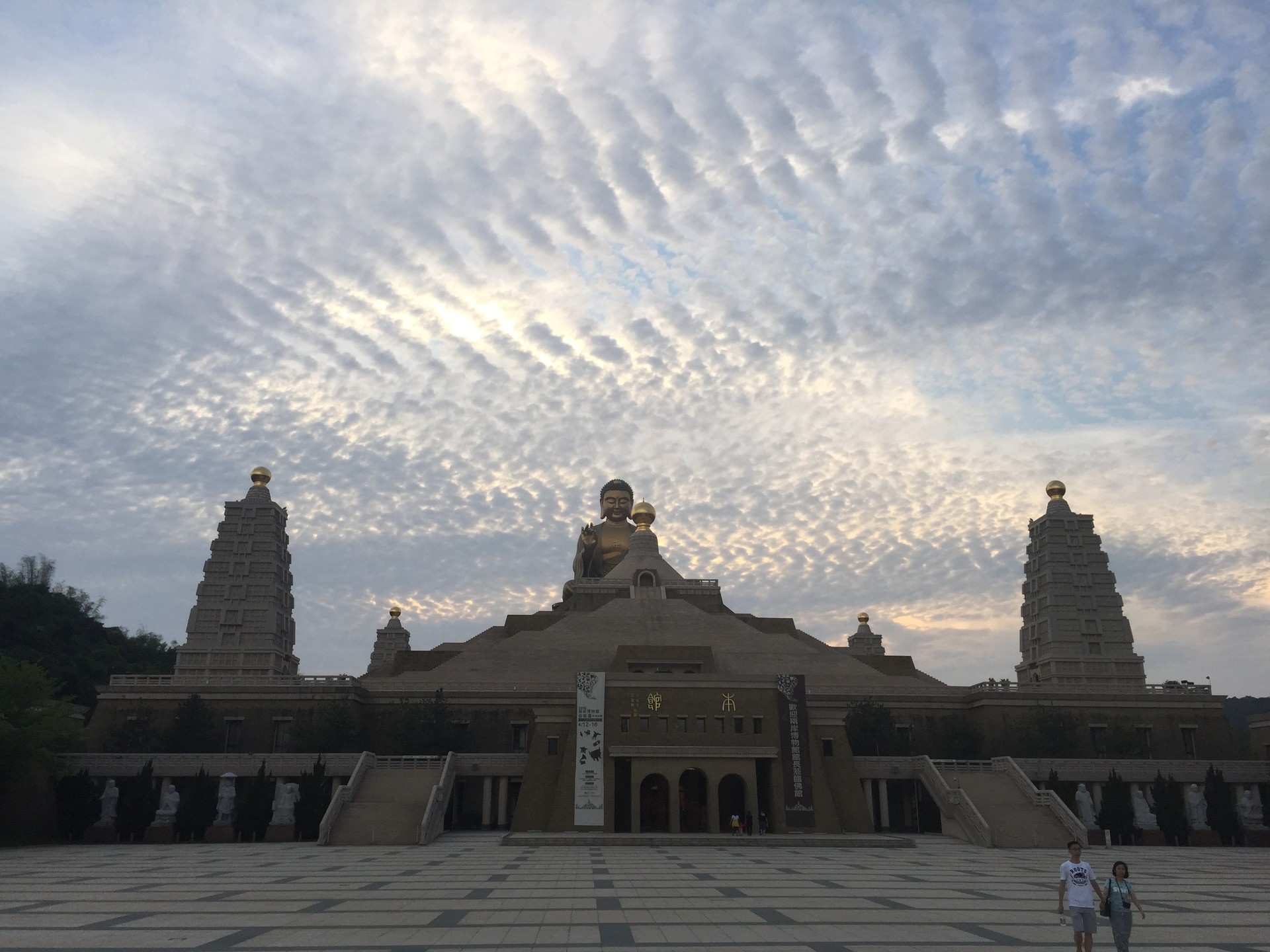
Getting to Fo Guang Shan Monastery from Kaohsiung:
From Kaohsiung Bus station (next to Guo Guang Bus station), you need to take bus #8010 heading to Jishan. Tickets can be purchased at the ticket counter inside the station or on the bus itself if you have the exact change. Tickets usually cost less than 100 NTD.
Here are links for the monasteries respectively:
Chung Tai Chan (Puli)
Fo Fuang Shan (Kaohsiung)
Following Taiwan I spent 5 months traveling across Philippines and Thailand, as well as around Myanmar and India; ending up volunteering and hiking in Nepal. Upon returning to Europe, I taught and traveled in Catalonia (Spain) for a summer camp. I will be writing more about some of those experiences soon.
Photo gallery
Content available in other languages
- Français: Fabriqué en Taïwan: Un guide pour vivre, voyager, et trouver un job de professeur d'Anglais
- Português: Feito em Taiwan: Um guia para viver, viajar e encontrar um trabalho ESL em Taiwan
- Español: Hecho en Taiwan: Una guía para vivir, viajar y encontrar un trabajo ESL en Taiwan
- Italiano: Guida per vivere, viaggiare e trovare lavoro a Taiwan come insegnante di lingua inglese
- Polski: Wyprodukowano na Tajwanie: przewodnik po życiu, podróżach i nauczaniu ESL na Tajwanie
Share your Erasmus Experience in Taichung!
If you know Taichung as native, traveler or as exchange student... share your opinion on Taichung! Rate different characteristics and share your experience.
Add experience →


































Comments (0 comments)